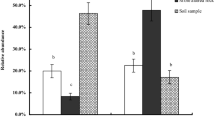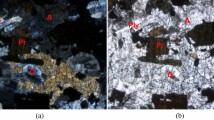Abstract
Bacteria play important roles in rock weathering, elemental cycling, and soil formation. However, little is known about the weathering potential and population of bacteria inhabiting surfaces of rocks. In this study, we isolated bacteria from the top, middle, and bottom rock samples along a hillside of a rock (trachyte) mountain as well as adjacent soils and characterized rock-weathering behaviors and populations of the bacteria. Per gram of rock or surface soil, 106–107 colony forming units were obtained and total 192 bacteria were isolated. Laboratory rock dissolution experiments indicated that the proportions of the highly effective Fe (ranging from 67 to 92 %), Al (ranging from 40 to 48 %), and Cu (ranging from 54 to 81 %) solubilizers were significantly higher in the top rock and soil samples, while the proportion of the highly effective Si (56 %) solubilizers was significantly higher in the middle rock samples. Furthermore, 78, 96, and 6 % of bacteria from the top rocks, soils, and middle rocks, respectively, significantly acidified the culture medium (pH < 4.0) in the rock dissolution process. Most rock-weathering bacteria (79 %) from the rocks were different to those from the soils and most of them (species level) have not been previously reported. Furthermore, location-specific rock-weathering bacterial populations were found and Bacillus species were the most (66 %) frequently isolated rock-weathering bacteria in the rocks based on cultivation methods. Notably, the top rocks and soils had the highest and lowest diversity of rock-weathering bacterial populations, respectively. The results suggested location-related differences in element (Si, Al, Fe, and Cu) releasing effectiveness and communities of rock-weathering bacteria along the hillside of the rock mountain.





Similar content being viewed by others
References
Lapanje A, Wimmersberger C, Furrer G, Brunner I, Frey B (2012) Pattern of elemental release during the granite dissolution can be changed by aerobic heterotrophic bacterial strains isolated from Damma Glacier (central Alps) deglaciated granite sand. Microb. Ecol. 63:865–882
Barker WW, Welch SA, Chu S, Banfield JF (1998) Experimental observations of the effects of bacteria on aluminosilicate weathering. Am. Mineral. 83:1551–1563
Santelli CM, Welch SA, Westrich HR, Banfield JF (2001) The effect of Fe-oxidizing bacteria on Fe-silicate mineral dissolution. Chem. Geol. 180:99–115
Benzerara K, Barakat M, Menguy N, Guyot F, De Luca G, Audrain C, Heulin T (2004) Experimental colonization and alteration of orthopyroxene by the pleomorphic bacteria Ramlibacter tataouinensis. Geomicrobiol J. 21:341–349
Drozdova OY, Shirokova LS, Сarrein A, Lapitskiy SA, Pokrovsky OS (2015) Impact of heterotrophic bacterium Pseudomonas aureofaciens on the release of major and trace elements from podzol soil into aqueous solution. Chem. Geol. 410:174–187
Hutchens E, Valsami-Jones E, McEldowney S, Gaze W, McLean J (2003) The role of heterotrophic bacteria in feldspar dissolution—an experimental approach. Mineral. Mag. 67:1157–1170
Potysz A, Grybos M, Kierczak J, Guibaud G, Lens PNL, van Hullebusch ED (2016) Bacterially-mediated weathering of crystalline and amorphous Cu-slags. Appl. Geochem. 64:92–106
Chen W, Luo L, He LY, Wang Q, Sheng XF (2016) Distinct mineral weathering behaviors of the novel mineral-weathering strains Rhizobium yantingense H66 and Rhizobium etli CFN42. Appl. Environ. Microbiol. 82:4090–4099
YJ Y, Sheng XF, He LY, Huang Z (2016) Linkage between culturable mineral-weathering bacteria and their weathering effectiveness along a soil profile. Geomicrobiol J. 33:10–19
Huang J, Sheng XF, Xi J, He LY, Huang Z, Wang Q, Zhang ZD (2014) Depth-related changes in community structure of culturable mineral weathering bacteria and in weathering patterns caused by them along two contrasting soil profiles. Appl. Environ. Microbiol. 80:29–42
Calvaruso C, Turpault MP, Leclerc E, Ranger J, Garbaye J, Uroz S, Frey-Klett P (2010) Influence of forest trees on the distribution of mineral weathering-associated bacterial communities of the Scleroderma citrinum mycorrhizosphere. Appl. Environ. Microbiol. 76:4780–4787
Wang Q, Cheng C, He LY, Huang Z, Sheng XF (2014) Characterization of depth-related changes in bacterial communities involved in mineral weathering along a mineral-rich soil profile. Geomicrobiol J. 31:431–444
Barton HA, Taylor NM, Kreate MP, Springer AC, Oehrl SA, Bertog JL (2007) The impact of host rock geochemistry on bacterial community structure in oligotrophic cave environments. Int. J. Speleol. 36:93–104
Lepleux C, Turpault MP, Oger P, Frey-Klett P, Uroz S (2012) Correlation of the abundance of betaproteobacteria on mineral surfaces with mineral weathering in forest soils. Appl. Environ. Microbiol. 78:7114–7119
Uroz S, Kelly LC, Turpault MP, Lepleux C, Frey-Klett P (2015) The mineralosphere concept: mineralogical control of the distribution and function of mineral-associated bacterial communities. Trends Microbiol. 23:12751–12762
Newman DK, Banfield JF (2002) Geomicrobiology: how molecular-scale interactions underpin biogeochemical systems. Science 296:1071–1077
Gleeson D, McDermott F, Clipson N (2007) Understanding microbially active biogeochemical environments. Adv. Appl. Microbiol. 62:81–104
Balland C, Poszwa A, Leyval C, Mustin C (2010) Dissolution rates of phyllosilicates as a function of bacterial metabolic diversity. Geochim. Cosmochim. Acta 74:5478–5493
Yeomans JC, Bremmer JM (1998) A rapid and precise method of routine determination of organic carbon in soil. Commun. Soil Sci. Plant Anal. 19:1467–1476
Mehlich A (1984) Mehlich 3 soil test extractant: a modification of Mehlich 2 extractant. Comm Soil Sci Plant Anal 15:1409–1416
Wang XD, Yamaguchi N, Someya T, Nasu M (2007a) Rapid and automated enumeration of viable bacteria in compost using a micro-colony auto counting system. J Microbiol Meth 71:1–6
Schwyn B, Neilands JB (1987) Universal chemical assay for the detection and determination of siderophores. Anal. Biochem. 160:47–56
Manjanatha MG, Loynachan TE, Atherly AG (1992) Tn5 mutagenesis of Chinese Rhizobium fredii for siderophore overproduction. Soil Biol. Biochem. 24:151–155
Sambrook J, Russell D (2001) Molecular cloning, a laboratory manual. Cold Spring Harbor Laboratory Press, NY
Lane DJ (1991) 16S/23S rRNA sequencing. In: Stackebrandt E, Goodfellow M (eds) Nucleic acid techniques in bacterial systematics. John Wiley and Sons, New York, pp. 115–175
Altschul SF, Madden TL, Schaffer AA, Zhang J, Zhang Z, Miller W, Lipman DJ (1997) Gapped BLAST and PSIBLAST: a new generation of protein database search programs. Nucleic Acids Res. 25:3389–3402
Wang Q, Garrity GM, Tiedje JM, Cole JR (2007b) Naïve Bayesian classifier for rapid assignment of rRNA sequences into the new bacterial taxonomy. Appl. Environ. Microbiol. 73:5261–5267
Zhao F, Qiu G, Huang Z, He LY, Sheng XF (2013) Characterization of Rhizobium sp. Q32 isolated from weathered rocks and its role in silicate mineral weathering. Geomicrobiol J. 30:616–622
White AF, Brantley SL (1995) Chemical weathering rates of silicate minerals: an overview. In: White AF, Brantley SL (eds) Chemical weathering rates of silicate minerals. Reviews in mineralogy. Mineralogical Society of America, Washington, DC, pp. 1–22
Bennett PC, Hiebert FK, Choi WJ (1996) Microbial colonization and weathering of silicates in a petroleum-contaminated groundwater. Chem. Geol. 132:45–53
Buss HL, Lüttge A, Brantley SL (2007) Etch pit formation on iron silicate surfaces during siderophore-promoted dissolution. Chem. Geol. 240:326–342
Ferret C, Sterckeman T, Cornu JY, Gangloff S, Schalk IJ, Geoffroy VA (2014) Siderophore-promoted dissolution of smectite by fluorescent Pseudomonas. Environ. Microbiol. Rep. 6:459–467
Gleeson DB, Kennedy NM, Clipson N, Melville K, Gadd GM, McDermott FP (2006) Characterization of bacterial community structure on a weathered pegmatitic granite. Microb. Ecol. 51:526–534
Dopson M, Lovgren L, Bostrom D (2009) Silicate mineral dissolution in the presence of acidophilic microorganisms: implications for heap bioleaching. Hydrometallurgy 96:288–293
Sheng XF, Zhao F, He LY, Qiu G, Chen L (2008) Isolation and characterization of silicate mineral-solubilizing Bacillus globisporus Q12 from the surfaces of weathered feldspar. Can. J. Microbiol. 54:1064–1068
Certini G, Campbell CD, Edwards AC (2004) Rock fragments in soil support a different microbial community from the fine earth. Soil Biol. Biochem. 36:1119–1128
Acknowledgements
This work was supported by the Chinese National Natural Science Foundation under grants 41473075 and 41501257.
Author information
Authors and Affiliations
Corresponding author
Rights and permissions
About this article
Cite this article
Wang, Q., Wang, R., He, L. et al. Location-Related Differences in Weathering Behaviors and Populations of Culturable Rock-Weathering Bacteria Along a Hillside of a Rock Mountain. Microb Ecol 73, 838–849 (2017). https://doi.org/10.1007/s00248-016-0921-7
Received:
Accepted:
Published:
Issue Date:
DOI: https://doi.org/10.1007/s00248-016-0921-7




